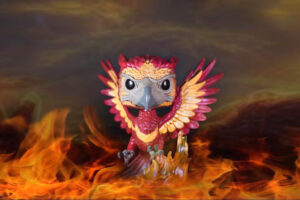Rising From The Ashes: The Eternal Myth Of The Phoenix
30th March 2023
Categorized Under: Playscripts
Comments (0)
RISING FROM THE ASHES: THE ETERNAL MYTH OF THE PHOENIX
For centuries, the myth of the Phoenix has captivated and inspired people around the world. This mythical bird is said to possess the power of reincarnation and be reborn from its ashes. From ancient Egypt to modern pop culture, the Phoenix has remained a symbol of hope, renewal, and resilience. But what is the story behind this legendary creature?
The Myth is believed to have originated in ancient Egypt, where it was associated with the sun god Ra and was considered a symbol of resurrection and eternal life. The Egyptians believed that the Phoenix was a sacred bird that lived for centuries before burning itself to ashes and being reborn from its ashes, representing the cyclical nature of life, death, and rebirth. Additionally, the myth was adopted later by the Greeks, who also saw it as a symbol of renewal and immortality. The Greek historian Herodotus wrote about the Phoenix in the 5th century BCE, describing it as a bird with colorful plumage that lived for 500 years before burning itself to ashes and being reborn.
The Phoenix is a bird of great beauty, bigger than an eagle, with radiant plumage in shades of gold, crimson, and purple. In some interpretations of the myth, the Phoenix lived for centuries before bursting into flames for three days in a nest of cinnamon twigs and dying in a fiery inferno to rise from its ashes anew with even greater strength and beauty than before. In others, the Phoenix flew to the temple of the sun to be reborn or consumed by flames and then rise again from the ashes.
From ancient myths to modern literature and film, the Phoenix continues to be a powerful symbol of transformation, hope and renewal. Its story reminds us that even in the face of destruction and adversity, we can rise from the ashes and begin again. The Phoenix teaches us that life is a cycle of birth, death, and rebirth and that each end is a new beginning. May we all find the courage and resilience of the Phoenix within ourselves, and rise again and again, stronger and more beautiful than before.
ORIGIN OF THE PHOENIX MYTH
Egyptian Mythology:
In ancient Egyptian mythology, the Phoenix was known as Bennu, which was believed to be a divine bird associated with the sun, creation, and rebirth. According to Egyptian myth, the Bennu bird lived in a tree that stood at the center of creation, which was thought to be located in the city of Heliopolis.
The Bennu was also said to represent the soul of the god Ra, who would be reborn each morning with the rising sun. The bird was depicted as having golden or red plumage, and was often shown with a sun disk on its head.
In some versions of the myth, the Bennu was said to periodically build a nest of cinnamon and myrrh and set it on fire, allowing itself to be consumed by the flames. From the ashes, a new Bennu would be reborn, representing the cycles of death and rebirth that were central to Egyptian religious beliefs.
The Bennu was also associated with the Nile River, and was believed to appear at times of great flood to herald the beginning of a new era. Overall, the Bennu was a powerful symbol of renewal and regeneration in Egyptian mythology, and its legend likely influenced the development of the Phoenix myth in other cultures.
Greek Mythology:
In ancient Greek mythology, the Phoenix was known as the ?????? (phoinix), which means “red” or “purple” in Greek. The story of the Phoenix in Greek mythology is similar to the Egyptian myth of the Bennu bird, but with some variations.
According to Greek legend, the Phoenix was a beautiful and sacred bird that lived in Arabia. It was said to have golden and red plumage, and was associated with the sun god Helios. The Phoenix was known for its ability to live for centuries before dying in a spectacular display of flames and then being reborn from its own ashes.
The Greek historian Herodotus described the Phoenix as a bird that resembled an eagle in size and shape, with golden feathers and a long, curved beak. He also wrote that the Phoenix would fly to the city of Heliopolis in Egypt every 500 years to build a nest of myrrh and other aromatic branches, and then set itself on fire. From the ashes, a new Phoenix would be born.
The Greek philosopher and scientist, Pliny the Elder, also wrote about the Phoenix in his work “Natural History”. He described the bird as having a lifespan of 500 years, after which it would build a funeral pyre and set itself on fire, only to be reborn from the ashes. Pliny also noted that the Phoenix was a symbol of immortality and renewal.
The Greek myth of the Phoenix shared many similarities with the Egyptian myth, and the story of the Phoenix became a popular motif in ancient literature and art. The legend of the Phoenix continues to captivate people today as a symbol of rebirth and regeneration.
Roman Mythology:
In Roman mythology, the Phoenix was known as the Phoenix or the Phoenix Aeternum, which means “eternal Phoenix.” The Roman version of the myth was heavily influenced by the Greek version, and the two are quite similar.
Like in the Greek myth, the Roman Phoenix was a beautiful and sacred bird with red and gold plumage. It was associated with the sun god Sol, and was believed to live for centuries before dying in a fiery blaze and then being reborn from its own ashes.
The Roman poet Ovid wrote about the Phoenix in his epic poem, “Metamorphoses.” He described the bird as being larger than an eagle, with feathers of gold and red. He also wrote that the Phoenix lived for 500 years before building a nest of cinnamon, myrrh, and other fragrant materials, and then setting itself on fire. From the ashes, a new Phoenix would be born.
The Roman scholar and philosopher, Pliny the Elder, also wrote about the Phoenix in his work, “Natural History.” He described the Phoenix as being similar to an eagle in appearance, with a lifespan of 500 years. He also noted that the Phoenix was a symbol of immortality and rebirth.
The Roman myth of the Phoenix closely mirrored the Greek myth, and both were influential in shaping the legend of the Phoenix that we know today.
A FEW LESSER-KNOWN FACTS ABOUT THE PHOENIX
-
The Phoenix is believed to be based on a real bird – While there is no evidence of a bird that can be reborn from its ashes, some scholars believe that the myth of the Phoenix may have originated from observations of the real-life phenomenon of bird molting. Molting is the process by which birds shed their old feathers and grow new ones, which could have been seen as a kind of rebirth.
-
The Phoenix is associated with the element of fire – The Phoenix’s ability to be reborn from its own ashes is often seen as a symbol of the transformative power of fire. Fire is traditionally associated with purification and regeneration, and the Phoenix’s connection to fire underscores its role as a symbol of renewal and rebirth.
-
The Phoenix appears in many different cultures – While the Phoenix is most commonly associated with ancient Egypt and Greece, similar birds appear in the folklore of many different cultures around the world. In Chinese mythology, for example, the Fenghuang is a bird that symbolizes peace and prosperity.
-
The Phoenix is sometimes depicted as male, sometimes as female – While the Phoenix is often referred to as “she” or “her,” some traditions depict the bird as male. In Arabic folklore, for example, the Phoenix is known as the Anqa and is described as a male bird.
-
The Phoenix is sometimes depicted with a snake or serpent – In some depictions of the Phoenix, the bird is shown holding a snake or serpent in its talons. This may symbolize the Phoenix’s mastery over death and decay, as snakes were traditionally associated with the underworld and the forces of decay and destruction.
Related Kidsinco’s posts:
The Phoenix’s Flight – Play Script
The Phoenix and the Magic Feather – Play Script
A Phoenix’s Journey: From Ashes To Glory
Click here to read Kidsinco’s Myths and Legends from Around the World
Click here to read Kidsinco’s Complete List of Playscripts:
Page 1
Page 2
Page 3
Page 4
Please read our Terms of Use
Instagram: @kidsinco
Tags: myths and legends, The Phoenix Myth



